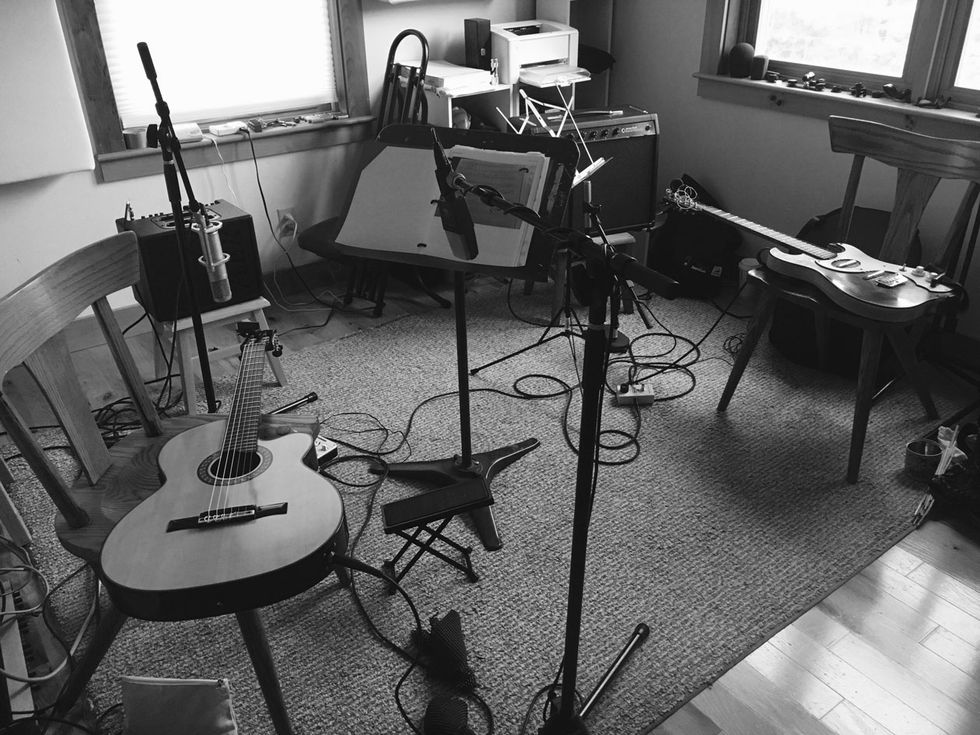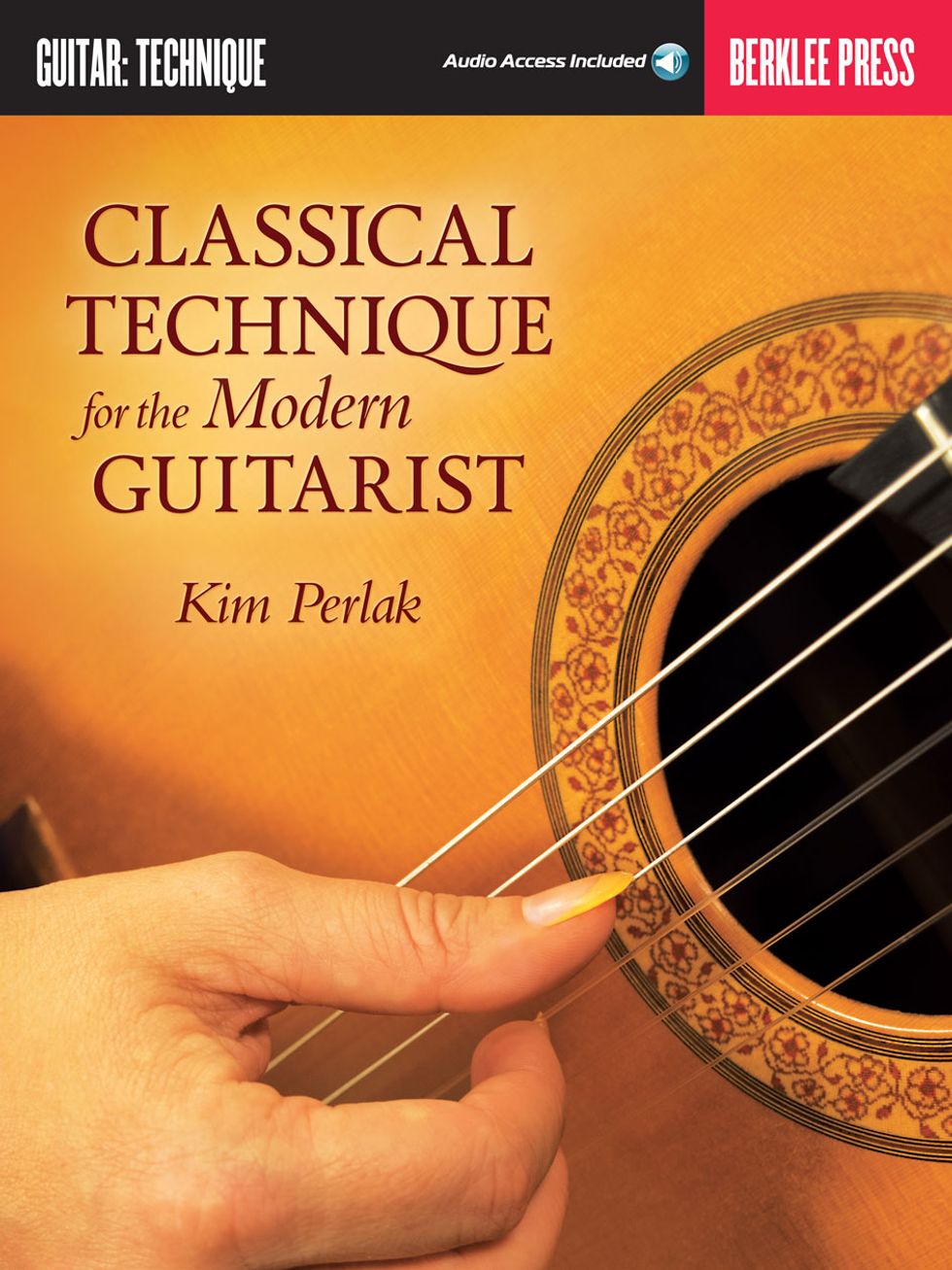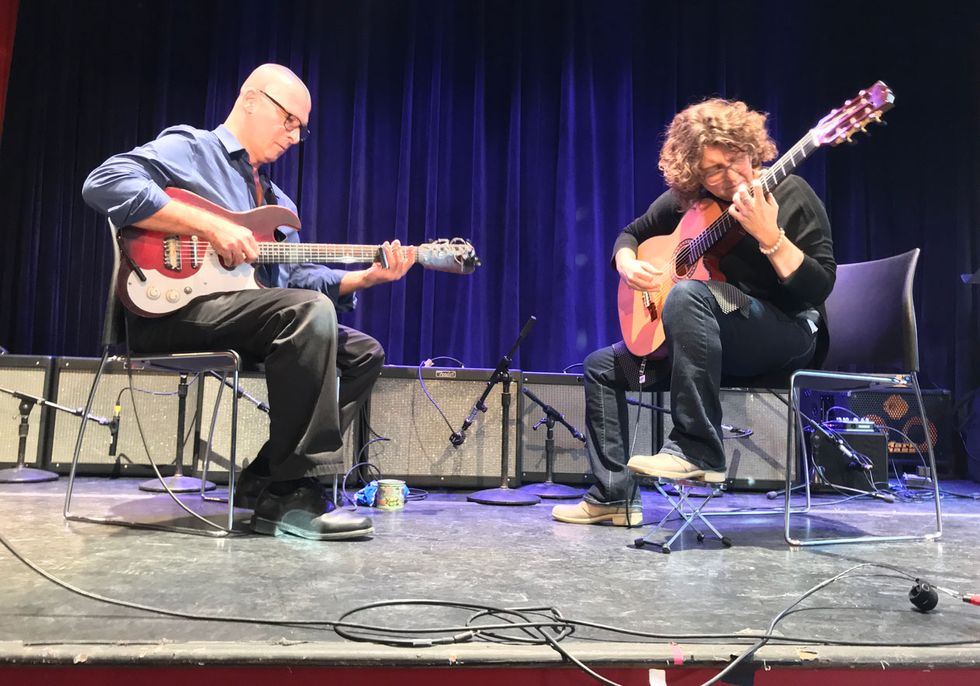The importance that the Berklee College of Music has had on the development of the guitar in the last half of the 20th century and beyond cannot be overstated. Ever since the Boston institution first offered guitar as a principal instrument, in 1962, it has been a breeding ground for some of the world’s great players—from improvisers like Bill Frisell and Emily Remler to highly technical rockers like Joe Satriani and Steve Vai to idiosyncratic singer-songwriters like Bruce Cockburn and St. Vincent. A walk past Berklee’s main campus, on Boylston Street, finds throngs of students with their guitar cases and gigbags, suggesting the instrument’s continuing prominence at the school.
Given all that, it’s surprising that in almost 60 years Berklee has only had four chairs of its guitar department. When Kim Perlak took this position last fall, she became the first woman to do so, and the first classical guitarist, as all three of her predecessors—Larry Baione, William Leavitt, and Jack Peterson, in reverse chronological order—had been jazz-oriented. But, presiding over about 1,000 guitar students who play in many different styles, Perlak is hardly the stuffy classical pedagogue.
A native of Western Massachusetts, Perlak, who is in her mid-40s, developed an affinity for the classical guitar at an early age. That’s thanks to sophisticated teachers and time spent in the Berkshires, where she was exposed to the Boston Symphony Orchestra at Tanglewood, the orchestra’s summer home. While Perlak solidified her technique and repertoire in the 1990s and ’00s—she has a BM from Stetson University, an MM from the Yale University School of Music, and a DMA from the University of Texas at Austin—she expanded her musical thinking and came to develop a voice on the classical guitar that’s modern yet firmly rooted in tradition, not to mention an openness to collaborating with musicians from outside of the classical world.
On a recent break from her packed schedule, Perlak phoned to talk about her earliest musical experiences, her academic journey and all that she’s picked up along the way, her magical Humphrey guitars, and why, as deep and seasoned a musician as she is, she still takes lessons.
What were your formative years like, musically speaking?
I grew up playing piano as a really young child, because my mom was a piano teacher. Then I started playing guitar around age 10. I took acoustic lessons from great teachers in music stores near where I lived, in Western Massachusetts. When I was 12, I began studying with this wonderful teacher named Suzi Higgins. She had a classical background and wrote acoustic music and played in a variety of different groups. My interest and love of the guitar just took off studying with her.
Suzi also had the great idea to put together a few of her students in a guitar quartet. I was the youngest in that group and it was really great. We rehearsed once a week at each other’s homes. It was like having a garage band, but being a classical guitar quartet. Then we started booking gigs at restaurants in Berkshire County, which, of course, is home to the Tanglewood Music Festival in the summertime. My summer job in high school was to play with these friends. Playing with them and learning with them was this incredible experience.
So my education was really centered in classical guitar. I had this background from studying with Suzi and my previous teachers in all different styles of guitar. I tried to keep that up as much as possible and play all kinds of different music that I loved. Then I really pursued an education in the classical style.
At a time when your classmates must’ve been into rock guitar, why did you choose the classical?
I loved the quiet nature of it. I love the self-sufficiency of it: being able to play a whole piece, all the different parts, as one person. I love the intimacy of it and the tone production, the way that you have to get to know your hands and how to produce a tone that is really varied, that has dramatic variation and expressive possibility just by using your fingers on an acoustic instrument. The enchantment with that is just something I’ve never lost.
I think one of the best things about playing the guitar in general is learning how to be expressive with your tone and with your sound. And the social aspect of joining this very close-knit community of musicians in the classical guitar community was incredible. When you think about it, the teachers I had in college were the first generation of American classical guitar teachers at that level. They had all studied with [Andrés] Segovia in master classes and some of them had studied with Segovia more formally. You’re touching history directly.
You become this instant part of guitar history and of the classical guitar in our country. And it was such an incredible way to meet people from all over the world. It was great for me, coming from a small town, and being a relatively shy person and having chosen a social instrument. It’s like you have an instant musical family, because you’re part of this larger tradition.
What does it feel like to have so few degrees of separation between you and Segovia and the rest of the tradition?
It’s a very moving experience to know that my guitar lineage is so powerful—knowing that I could sit with my teachers and they could tell me, “You know, this is how our guitar community began in this country and this is what I learned from Segovia, who is one of our living masters of the 20th century in music, and his peers.”

The Perlak/Tronzo Duo album was released in 2017 and features Kim Perlak on classical guitar and David Tronzo on slide guitar. Pictured on the cover is Perlak’s custom Kirk Sand guitar, which was modeled after the John Knowles Thinline model.
And really, you see how the tradition develops, because what I do in my musical life and my artistic life is so modern. It involves the influence of so many different styles of music that have been a part of my life in many different ways. Yet, it’s still really rooted in the tradition that I carry on from my teachers in classical music, and their teachers.
How would you say you found your own voice as, for lack of a better word, a classical guitarist?
I’ve had to have a real awareness of stylistic authenticity and personal authenticity and the balance of those two things. Continuing to really practice my instrument, develop my technique, and make sure that I stay steeped in tradition as a classical musician is important. So is approaching a modern style with the same commitment.
For example, when I’m working on being a better improviser, I really study the instrument in that way and work with collaborators and colleagues and teachers, even taking lessons. I continue to study and just deepen my skills and my awareness of that style. Then, I ask myself where I want to go with it; how I’m going to combine these things. It’s giving each tradition its due respect and then stepping back from that and asking myself artistically where I really feel like I want to be expressive.
You mentioned collaborating. What has it been like to work with people from outside of the classical world, like your Berklee colleague David Tronzo?
This is one of the great joys of being at a place like Berklee, where there are so many incredible artists. That project with David Tronzo came out of a lesson swap. When I first heard him, I was so interested in his approach to the instrument, his sound, and the type of music he was playing. I asked him if he would teach me. He was interested in my tone production and my right-hand technique, so we did a lesson swap for about a year. Out of that, we started writing music for each other to play and we became a duo, which is now about five years in the works.
Playing with David challenges the way I see the instrument in every way. It inspires me to look at the fingerboard differently. It inspires me to think about my sound in a deeper way. It inspires me to think about what is possible with sound, because our approaches to the instrument are so different. What’s remarkable about it is that when you look at us separately, it might be be hard to think about people who are more different in their approach to the instrument. But the way we think about music and being expressive and going deeply into our traditions and our love of modern music and creating new music—all of those values are the same. We’re building on what we have in common and then melding together all of the beautiful differences.
I’ve noticed that when I do something that’s more in my wheelhouse stylistically, because I’ve branched out and studied with him, the way I learn music in general and think about it as a soloist is deeper and more organic. I think it’s also made me a better teacher.
David Tronzo and Kim Perlak perform at a 2018 guitar faculty concert at Berklee’s the Red Room at Cafe 939 venue. The pair started out giving each other lessons, and have been collaborating as a duo for five years. Photo by Abby Aronson
How so?
Because I’m constantly aware of what it feels like to be a beginner, to learn something challenging and to ask for help. When I walk into a classroom now, the students know that David and I are working together and that we’re teaching each other. I think that helps them relax into learning something that challenges them. I also think that I can see when someone may have a question they’re afraid to ask more readily. I can go over to that person in a class, or I can say to them in a private lesson, “Let’s talk about what you’re working on. This is a really challenging topic. Let’s see if we can break it down further.” It’s good all around in that way.
You mentioned improvisation. How does it work for you as a classical musician—how does it differ from the way a jazz musician might approach improvisation, and how is it similar?
With the improvisation I’m doing in this project with David, his suggestion in the beginning was for me to approach it through my instincts, to bring what I do as a classical musician to what I’m doing as an improviser. So right away we started talking about parameters of music: tone and timbre and range and thinking about form and phrases and lyricism and counterpoint and all kinds of textures. When we’re playing freely, these are the tools that I have.
I spend a lot of time with students working on modes, triads, seventh chords, and polytonal things. Then I recognize them because I’ve heard them in my repertoire and my fingers have played them. The real strength of my playing as an interpreter is thinking about how things sound. But when I improvise, I’m trying to build the parts and thinking about what to play.

Classical Technique for the Modern Guitarist by Kim Perlak showcases the main teaching philosophies behind her extensive training as a classical guitarist.
Now when David and I write something beautiful, he might say, “Okay, let’s take it apart and improvise with it; let’s build another section.” That’s the part where I sometimes feel like I’m going into the deep end of the ocean. Then I have to go and work on the materials, work on the building blocks, and internalize them so that I can use them to build things.
One of our students once watched us rehearsing. He said something like, “Oh wow, I could see that your greatest challenge is playing a thousand different things, and David’s greatest challenge is playing one thing a thousand different ways.” But what I’ve learned is to take my instincts and say, “Yes, you’re improvising, but you’re still an interpreter.”
You took quite the academic path en route to Berklee.
Yes. At Stetson, I set my foundation as a player. It was a small school, and there was this great sense of community in the guitar department. The 11 of us who were there really pushed each other in constructive ways. It’s where I really learned how to rely on great colleagues and just practice all the time. It instilled in me this passion for working hard and building relationships with other players.
At Yale, Benjamin Verdery was my teacher. Yale is a performance-oriented school and the level of musicianship is incredibly high. That’s where I really learned the professional expectations of a performer: You come to the rehearsal and you already know your part and play it beautifully. You don’t come to the rehearsal to learn; you come to the rehearsal to make music.
I also worked in the school’s recording studio as a producer. That taught me about transferrable skills and set me up to work in the studio and make some beautiful records, because being able to play and hear the difference between voices on an instrument and know about tone control and discern when things are out of tune are all critical skills that have translated into me being able to work.
Can you explain more about these transferrable skills you picked up?
Having practiced the instrument to the extent that I had, and really working on my ears, helped me to be a producer. Also, that job connected me further to musical communities that were not classical, because we did a lot of producing of jazz concerts.And so now, when students tell me, “I’m going to be a producer, so I don’t really need these private lessons,” I say, “No—you don’t know what you’re going to need.” And I just know for a fact that the work you put into your instrument can open all these doors that you can’t see when you’re young.
After Yale, I studied at the University of Texas at Austin, which was where I really developed my writing and teaching skills. I began teaching at the high-school level, building programs through a nonprofit, through the Austin Classical Guitar Society, and also working in colleges, and starting to develop those kinds of programs. Since I was pursuing my DMA, I spent a lot of time working with musicologists and learning how to write about music. And having to approach music in a deep research capacity has helped me see the differences and similarities in the traditions that I love.
When did you first arrive at Berklee, and what drew you to the institution?
I came to Berklee as the assistant chair of the guitar department in 2013. I was drawn to this school because I felt that it puts its resources behind all the things that are important about music and music education, with all of the different styles represented equally. I also felt that the values of the department are balanced between tradition and innovation, and encouraged students to come and do what they love, whether it’s jazz, classical, blues, rock, or a mix of these things together.
It’s a community of players—the largest and most stylistically diverse guitar department in the world. And there’s the sense that no matter what style you choose, you have to know your instrument deeply, in a technical way—the way it works, your fretboard, and all of the musical vocabulary. And you have to understand how your hands work, so that you can play safely, with beautiful tone and phrasing. And that you need to have a sense of how to work with other people, how to build relationships musically and professionally.
In a nutshell, would you say that your approach as the chair is to teach guitarists, regardless of their stylistic orientation, to have a deeper understanding of the instrument in general?
It’s not a classical guitar department. I just happen to have studied the classical guitar. It’s funny that you say that, because people will always ask, “Is this a jazz school?” Because the tradition of Berklee is jazz-based. I would say my philosophy in general is to be the chief advocate of a guitar department that values every style, and that respects equally tradition and innovation in each of those styles.

Guitars
1990 Thomas Humphrey Millennium with 640 mm scale fretboard, spruce top, rising sun bracing, and Brazilian rosewood back and sides
2003 Thomas Humphrey Millennium with 640 mm scale fretboard, spruce top, lattice bracing, and Brazilian rosewood back and sides
Kirk Sand John Knowles Thinline custom
Collings 01E (just for fun)
Amps and Effects
Custom Fishman Aura Acoustic Imaging pedal
AER Compact 60
Strings and Picks
D’Addario Pro-Arté EJ46 (.0285–.044) or EXP46 (.029–.046) for classical guitars)
D’Addario EJ40 Silk and Steel (.011–.047) (on Collings 01E)
What’s something exciting that you’ve been up to lately at Berklee?
I started a contemporary classical ensemble in this semester, teaching it with David Tronzo, and it’s about interpreting and improvising and writing new guitar material. That ensemble has a collaboration with a regional festival, so the students can premiere their work in a concert with 10 other music schools and conservatories. And so, from a curriculum development standpoint, there is every opportunity to do something valuable and artistic. That’s translated well for me, because I feel like my career, up until coming here as assistant chair, was based on having roots in the classical tradition, but a love and a continuing study of many traditions of music.
On a different note, talk about your concert guitars.
My two main guitars are by Thomas Humphrey, both with Brazilian rosewood back and sides, for warmth and depth of tone. Tom was based in New York City and was a fixture in the guitar community for years. He invited guitarists who played his instruments to spend time at his home. He would cook for us, listen to us play, and take extensive notes. When I was in college, I bought my first Humphrey, made in 1990, from a woman who couldn’t play it anymore.
I was encouraged to contact Tom, and then he took me under his wing. Over the years of knowing him and playing for him, he built me a guitar based on his perceptive observations. My 2003 Humphrey is the one he built for me. The top is Engelmann spruce, with lattice bracing that incorporates some graphite, for volume. That guitar has the sound that I’m always looking for: this lyrical, clear, well-defined, fat beautiful tone, with an unmistakable voice separation.
When I came to Berklee, I realized I wanted something—especially for the duo with David Tronzo—that would be a beautiful-sounding, nylon-string instrument with the capabilities of an electric guitar. John Knowles and Tommy Emmanuel—Chet Atkins’ C.G.P.s [Certified Guitar Players]—happened to be in Boston when I was thinking about this, and they recommended I contact a guitar maker named Kirk Sand. So, I got in touch with Kirk, told him what I was looking for, and he took the body of the John Knowles Thinline model, had me measure the neck of my Tom Humphrey guitar, and built me a hybrid. That is a beautiful-sounding instrument.
What are you using for sound reinforcement with the Sand guitar?
The wonderful people at Fishman had me over to their studios to record with my favorite microphones, and then they put those sounds in an Aura Acoustic Imaging pedal. I generally use that pedal and an AER amp, for this beautiful, wonderfully full sound that blends so nicely with David’s slide-guitar playing on his electric guitar.
When I talk about these things, it makes me realize how much being here at Berklee, in this community of all of these styles together, has influenced my concept of sound, and what’s possible, because the advice you can get in terms of what you’re looking for, and how to match it with the right tool, is really endless.
Kim Perlak plays a piece by her former teacher Benjamin Verdery in this concert video from Boston GuitarFest.
Watch Kim Perlak in her adventurous duet with Berklee colleague David Tronzo in this faculty night performance, starting at the 6:05 mark.












![Rig Rundown: Russian Circles’ Mike Sullivan [2025]](https://www.premierguitar.com/media-library/youtube.jpg?id=62303631&width=1245&height=700&quality=70&coordinates=0%2C0%2C0%2C0)













![Rig Rundown: AFI [2025]](https://www.premierguitar.com/media-library/youtube.jpg?id=62064741&width=1245&height=700&quality=70&coordinates=0%2C0%2C0%2C0)




















 Zach loves his Sovtek Mig 60 head, which he plays through a cab he built himself at a pipe-organ shop in Denver. Every glue joint is lined with thin leather for maximum air tightness, and it’s stocked with Celestion G12M Greenback speakers.
Zach loves his Sovtek Mig 60 head, which he plays through a cab he built himself at a pipe-organ shop in Denver. Every glue joint is lined with thin leather for maximum air tightness, and it’s stocked with Celestion G12M Greenback speakers.











